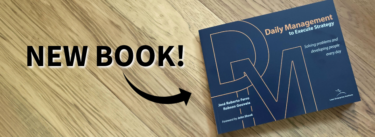Editor’s Note: This article was originally published February 20, 2013. It is the second of six in a series focused on exploring lean transformation.
Leadership Again
When you see good leadership, follow it if you wish.
If you don’t see it, take it. If you wish.
If you don’t, don’t complain.
In my last letter I alluded to a common view in the Lean Community – shared by the broader business community at large – that promotes the notion of the heroic leader, riding a stallion into a troubled situation issuing directives and saving the day. “The leader must lead” the dictum goes. Well, yes, the leader must lead. But, what does that mean?
I am growing ever more leery of cries for “strong leadership” of the hero variety with the leader exercising command and control, telling the troops what to do. This view not only misses the point, it obscures the real issue. The issue isn’t “leadership” at all; it’s what leadership accomplishes. As long as any system is dependent on “leadership” it is fragile and dependent – literally – on the individual who happens to be in charge today. Fans of charismatic or forceful leadership squirm at this message. But over time I have come to think that the real issue is learning to build systems that accomplish the things we advocate (problem solving culture, individuals engaged in continuous improvement, etc.).
Lean practice represents a fundamentally different type of leadership. Lean leadership is highly situational in practice, yet consistent in underlying principle; flexible and adaptive in situation-based action, yet solidly rooted in an unwavering way of thinking. There are occasions that call for more directive leadership behavior and those that call for patient consensus building, always in pursuit of attaining organizational purpose. But, lean thinking in practice calls for more than just leadership that sways with the situation of the moment. Close examination reveals a few common denominators. Observable behaviors include demonstrations of respect for people, rigorous application of scientific thinking, and flexible application of practices to solve problems and continuously improve processes. Observable behaviors – things we can see; things we can choose to do.
Most important of all, lean leadership isn’t a matter of position, it’s a matter of action. Action that can be taken at any level, in any situation, and the leadership can work down, up, or sideways.
(For a look at what those behaviors are, click here)
Leading Up at NUMMI
Here’s another example from that organization I often use for illustration, the joint venture between Toyota and General Motors: New United Motor Manufacturing, Inc. (NUMMI).
One advantage NUMMI (and many other transplant companies of the 1980s) enjoyed was a substantial allocation of resources from the headquarters (the home culture) to kick-start the creation of a local, hybrid culture in North America. In the first year or so, Toyota dispatched about 400 “trainers”, technical specialists, to NUMMI on rotating three-month assignments.
Group Leader Hyodo was assigned to support a model changeover in assembly. Hyodo graduated from a technical high school and started working as an assembly line worker for Toyota’s Takaoka Assembly plant when he was about 18 years old. After ten years, Hyodo was promoted to Team Leader along with most of his colleagues that entered at the same time. Five years later, he was promoted to Group Leader, in charge of a group of less than 30 team members and leaders. At NUMMI, he was responsible for supporting the work of a larger group and, now, facilitating the learning required to achieve a successful launch.
As leader of the final assembly launch team, Hyodo was developing the skills of his team members while working to ensure the best possible design of jobs for the workers who would perform the work on the assembly line The work needed to be designed so that it developed people as they carried it out – an ambitious target condition and a challenge to develop job designers with that skill!
His launch team was learning to build dollies and fixtures, to design efficient standardized work, to balance and rebalance jobs while eliminating waste, ergonomic concerns and other problems. He wasn’t just designing good jobs, he was building good job designers and problem-solvers. The immediate problems that Hyodo was focused on were problem-solving capability itself, along with job design skills. NUMMI had initiated some training to enhance standardized work design and problem-solving skills, but Hyodo saw that the training was too removed from the gemba.
Hyodo recognized the good intentions of the training being offered by the HR department but also knew that developing excellent job design skills requires – more than anything – deep understanding of the work itself and how the actual work impacts each individual on the assembly line. As his team did its work, Hyodo found many of his team’s ideas being rejected, sometimes by senior managers in HR, sometimes by senior production managers. Hyodo concluded that the HR and production organizations were misaligned. His solution? Arrange for HR representatives to be assigned full time to his launch team. This was a smart move on the surface – he would get alignment and learning at the front lines of the organization.
If it was a smart move on the surface, it was a brilliant move when examined more deeply. From the very fact that neither the HR nor the production organizations were in favor of the proposal, Hyodo knew that the matter would have to escalate to the highest levels. And therein lay his real objective: he was intentionally causing highest levels of the organization to talk to each other about the problem.
So, he pushed his ideas. Hyodo pushed his ideas because he wanted to instigate conflict at the lowest levels of the organization precisely because he knew that it would force the highest levels (vice presidents) to work together for the betterment of the overall company.
Hyodo knew the poison of high-level corporate systems operating independently of the real world gemba reality. So he decided to deliberately drive issues on the floor with the specific intent of creating conflict to force high-level cross-functional dialogue and progress.
Wow.
A high-school educated shop-floor rat (a union member, by the way) intentionally introducing technical change on the plant floor in order to disturb the social system at the broader level. That’s lean leadership.
Doesn’t sound like a typical illustration of the kind of leadership practices that many companies are trying to establish. But, that’s what it looks like eventually. Front-line value creators not just being led but leading.
(For a deeper dive into Hyodo’s story and a look into how it relates to “hoshin kanri” click here.)
So, that’s what those opening words mean. Don’t look outside yourself for leadership. Take it.
When you see good leadership, follow it if you wish.
If you don’t see it, take it. If you wish.
If you don’t, don’t complain.






